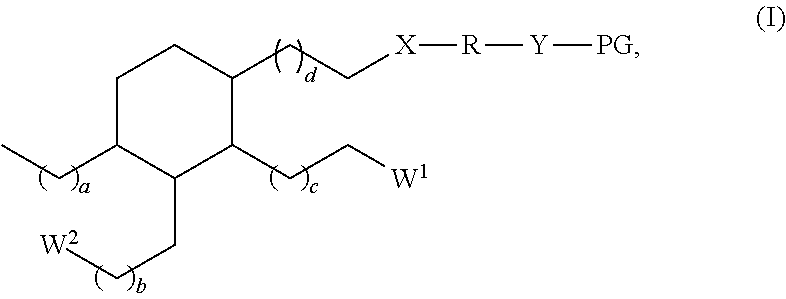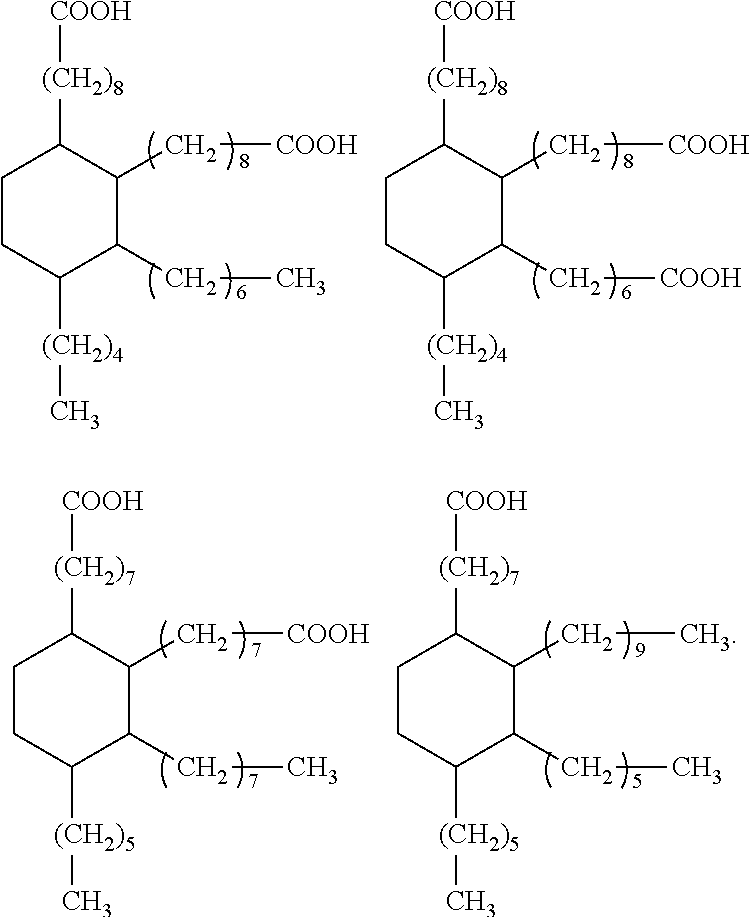Dental materials based on dimer acid derivatives with ring opening polymerizable groups
a technology of dimer acid derivatives and dimer acid derivatives, which is applied in the field of monomers derived from hydrogenated dimer acids with ring opening polymerizable groups, can solve the problems of marginal gap formation, reduced substrate adhesion, and impairment of the dimensional stability of prosthesis plastics, and achieves the effect of reducing the shrinkage of polymerization
- Summary
- Abstract
- Description
- Claims
- Application Information
AI Technical Summary
Benefits of technology
Problems solved by technology
Method used
Image
Examples
specific example
[0074]
[0075]In other cases, it may be necessary to convert one or more carboxylic acid groups of the hydrogenated dimer acid into a suitable different functional group. Appropriate methods are known in principle from organic chemistry. Suitable methods for converting the carboxylic acid groups of hydrogenated dimer acids into different functional groups are also discussed for example in US 2008 / 0318188 A.
[0076]Suitably functionalized cyclic monomers for the synthesis of the monomers according to the invention of formula (I) are known from literature. For example, the synthesis of vinylcyclopropanes and of bicyclic cyclopropyl acrylates is described by N. Moszner et al. in Macromol. Rapid. Commun. 18 (1997) 775-780 and by A. de Meijere et al. in Eur. J. Org. Chem. (2004) 3669-3678, respectively, while the synthesis of functionalized cyclic allyl sulphides was described e.g. by R. A. Evans and E. Rizzardo in J. Polym. Sci., Part A. Polym. Chem. 39 (2001) 202-215 and Macromolecules 33 ...
example 1
Synthesis of a Ring-Opening Polymerizable Hydrogenated Dimer Acid Derivative RODA
[0121]21.09 g (0.110 mol) N-(3-dimethylaminopropyl)-N′-ethylcarbodiimide hydrochloride was added portionwise at 0° C. within 2 h to a solution of 17.63 g (0.100 mol) 7-methylene-1,5-dithiacyclooctan-3-ol, 28.25 g (0.050 mol) dimer acid and 0.611 g (0.005 mol) 4-dimethylaminopyridine in 200 ml anhydrous methylene chloride. After 6 h of stiffing at 0° C., 500 ml water was added to the reaction mixture. After phase separation, the organic phase was washed with 2 N hydrochloric acid (2×100 ml) and water (2×100 ml), dried with anhydrous sodium sulphate and the solvent was removed. After chromatographic purification over silica gel (hexane / ethyl acetate 4:1), 24.10 g (55%) of a colorless, viscous liquid (η=7.70 Pa·s) was obtained.
[0122]1H-NMR (400 MHz, CDCl3): δ (ppm)=0.83-0.90, 1.04-1.47, 1.57-1.60 (3 m, 62H, CH, CH2, CH3; a), 2.27 (t, J=7.5 Hz, 4H, O═C—CH2; b), 3.02 and 3.03 (2 d, J=1.68 Hz, 3.28 Hz, in eac...
example 2
Synthesis of a Methacrylated Dimer Acid Derivative DMDA
PUM
| Property | Measurement | Unit |
|---|---|---|
| Fraction | aaaaa | aaaaa |
| Fraction | aaaaa | aaaaa |
| Fraction | aaaaa | aaaaa |
Abstract
Description
Claims
Application Information
 Login to View More
Login to View More - R&D
- Intellectual Property
- Life Sciences
- Materials
- Tech Scout
- Unparalleled Data Quality
- Higher Quality Content
- 60% Fewer Hallucinations
Browse by: Latest US Patents, China's latest patents, Technical Efficacy Thesaurus, Application Domain, Technology Topic, Popular Technical Reports.
© 2025 PatSnap. All rights reserved.Legal|Privacy policy|Modern Slavery Act Transparency Statement|Sitemap|About US| Contact US: help@patsnap.com



